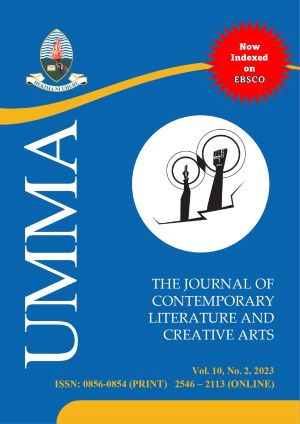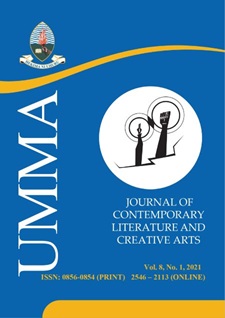Appraisal of the Use of Metaphors in the Holy Qur ' an
Abstract
This study appraised the use of metaphors in the Holy Qur ' an, guided by Lakoff and Johnson ' s Conceptual Theory of Metaphor (1980). Data were collected from thirteen chapters of the Holy Qur ' an that were purposively selected out of one hundred and fourteen chapters through the purposive criterion sampling technique. Results revealed that structural metaphors occurred most, followed by orientational metaphors and lastly ontological metaphors. Impliedly, the Qur ' anic metaphors observed from selected chapters of the Holy Qur ' an are more structural than orientational or ontological. Thus, the study confirmed the existence of conceptual types of metaphors by Lakoff and Johnson (1980) in the Holy Book of the Holy Qur ' an.
Keywords:
Holy Qur ' an, Orientational Metaphors, Ontological Metaphors
References
Alama, F.A.S. 2018, Translation of metaphor: An evaluative comparative study of a sample of Quran metaphors with reference to four English translation versions of the Holy Quran. Unpublished PhD dissertation. Sudan University of Science and Technology.
Ali, R., & Sardaraz, K. 2021, Dichotomy of languages and thought in the interpretation of metaphor in the Qur ' an. Journal of Nusantara Studies (JONUS), vol, 6, no.1, pp.95-117. DOI: 10.24200/jonus.vol6iss1pp95-117
Al-Khatib, A.M. 2012, Politeness in the Holy Quran: A sociolinguistic and pragmatic perspective. Intercultural Pragmatics, vol. 9, no. 4, pp. 479-509. DOI:10.1515/ip-2012-0027
Al-Zoubi, M. A. M., & Al Husanawi, A. 2006, Cogon-cultural issues in translating metaphor, Perspectives-studies in translatology. Amman, Unpublished Master ' s Thesis, Jordan University of Science and Technology, Jordan.
American Heritage Dictionary of the English Language 2015, https://ahdictionary.com/word/search.html?q=metaphor
Bose, A., Marinis, T., & Sundaray, S. 2018, Comprehending non- literal language: effects of ageing` and bilingualism. Original. Frontiers in Psychology. DOI: 10.3389/fpsyg.2018.02230. Retrieved from https://www.frontiersin.org/articles/10.3389/fpsyg.2018.02230/full
Dawadi, S., Shrestha, S., & Giri, R. A. 2021, Mixed-methods research: a discussion on its types, challenges, and criticisms, Journal of Practical Studies in Education, vol. 2, no. 2, pp. 25-36.
Eldin, A. 2014, Cognitive metaphorical analysis of selected verses in the holy Quran, International Journal of Linguistics, vol. 4, no. 6, pp. 16-21. Doi: 10.5539/ijel.v4n6p16
End, J.L. 1986, Grounds for Metaphor Comprehension. Advances in Psychology, vol. 39, pp. 327-345.
Fiawornu, Y. V., Kubi, B., Laryea, O.C., & Ofori, A.E. 2021, The use of metaphors and similes in a political discourse in Ghana, Journal of Contemporary Research, vol. 18, no. 2, pp. 74-95.
Gathigia, M., Wang, R., Shen, M., & Tirado, C. 2018,. A cross-linguistic study of metaphors of death, Cognitive linguistic studies, vol. 5, no. 2, pp. 350- 375.
Grix, J. 2001, Demystifying postgraduate research,: University of Birmingham Press, Birmingham, UK.
Guba, E. G., & Lincoln, Y. S. 1981, Effective evaluation, Jossey-Bass, San Francisco, CA.
Hardiyanti, R. A. 2019, Conceptual metaphors used in Instagram captions by Indonesian teenagers: Gender perspectives, Unpublished Thesis, University of Islam Negeri Maulana Malik Ibrahim Malang.
Hassanein, A. M. 2019, Conceptual metaphors in the Holy Qur ' an: A cognitive linguistic approach, Unpublished PhD Dissertation., University of Suez.
Ismail et al. (2021) Impact of Quran memorization on psychological and health well-being, Review of International Geographical Online., vol. 11, no. 8, pp. 337-344. DOI:10.48047/rigeo.11.08.33
Kabir, S. M. S. 2016, Sample and sampling design: Basic guidelines for research (pp. 168-180). https://www.researchgate.net
Karimova, V. 2015, Metaphor in political discourse, Unpublished MA Thesis, Khazar University.
Kennett, N.Y., Gold, R., & Faust, M. 2018, Metaphor comprehension in low and high creative individual, Frontiers in Psychology, vol. 9, p. 482, doi: 10.3389/fpsyg.2018.00482.
Knowles, M., & Moon, R. (2005). Introducing Metaphor, Routledge, New York.
KÓ§vecses, Z. 2008, Conceptual metaphor theory: Some criticisms and alternative proposals, Annual Review of Cognitive Linguistics, vol. 6, pp. 168-184.
Lakoff, G., & Johnson, M. 1980, Metaphors we live by, The University of Chicago Press, Chicago, IL.
Lakoff, G., & Johnson, M. 2003. Metaphors we live by, The University of Chicago Press, Chicago, IL.
Lakoff, G., & Johnson, M. 1999, Philosophy in the flesh: The embodied mind and its challenge to Western Thought, Basic Books, New York.
McCombes, S. 2019, How to do a case study. Course Hero. https://www.coursehero.com/file/76286889/How-to-Do-a-Case-Study-McCombespdf/
Mio, S. J. 1997, Metaphor and politics, Metaphor and Symbol, vol. 12, no. 2, pp. 113-133.
Mohammad, M.S., Shutova, E., & Turney, D.P. 2016, Metaphor as a medium for emotion: an empirical study, Proceedings of the Fifth Joint Conference on Lexical and Computational Semantics, pp 23-33.
Moser, S.K. 2000, Metaphor analysis in psychology- method, theory, and fields of application, Forum Qualitative Sozialforschung/Forum: Qualitative Social Research (On-line Journal), vol. 1, no. 2. https://doi.org/10.17169/fqs-1.21090
Mouton, G. 2013, Economy is an organism €“ a comparative study of metaphor in English and Russian economic discourse, Text & Talk, vol. 33, no. 2, pp. 260-288.
Nabilla, B. 2018, Metaphor in the translation of Surah Ash-Shuraa. Unpublished Thesis, University Islam Negeri Maulana Malik Ibrahim Malang.
Naicker, S. 2016, A cognitive linguistic analysis of conceptual metaphors in Hindu religious discourse with reference to Swami Vivekananda ' s complete works, Unpublished PhD dissertation, University of South Africa
Nordquist, R. 2020, Definition and examples of target domain in conceptual metaphors. ThoughtCo. https://www.thoughtco.com/conceptual-domain-metaphor-1689900
Nurbayan, Y. 2019, Metaphors in the Quran and its translation accuracy in Indonesian, Indonesian Journal of Applied Linguistics, vol. 8, no. 3, pp. 710-715
Pragglejaz Group (2007), MIP: A method for identifying metaphorically used words in discourse, Metaphor and Symbol, vol. 22, no. 1, pp. 1-39.
Rapp, A., & Wild. 2011, Nonliteral language in Alzheimer dementia: A review, Journal of the International Neuropsychological Society, vol. 17, no. 2, pp. 1-12. DOI:10.1017/S1355617710001682
Ruma 2014, Concretizing the abstract: conceptual metaphors in the Holy Qur ' an. https://www.researchgate.net/publication/269078980_ ' Concretizing_the_Abstract_Conceptual_Metaphor_in_the_Holy_Qur ' an
Saheeh International-Riyadh, 1997, THE QUR ' AN: Arabic Text with Corresponding English Meanings, Abdulqasim Publishing House, London.
Sazdovska, M. 2017, Use of metaphors and metonomy in economic discourse, vol. 2, no. 17, p. 10, DOI:10.20544/HORIZONS.A.21.2.17.P10
Sharifi. A.E., & Kordasiabi, R. M. 2020, The role of ideology in enhancing political ethics at level of international relations from the perspective of the Holy Quran and Hadiths, International Journal of Multicultural and Multireligious Understanding, vol. 7, no. 10, pp. 709-723.
Soskice, J. M. 1985, Metaphor and religious language, Clarendon, Oxford.
Tendahl, M. 2009, A hybrid theory of metaphor: relevance theory and cognitive linguistics, Palgrave Macmillan, Germany.
Tonon, C. 2020, Metaphors of psychological deterioration: the case of depression, Le Simplegadi, vol. 18, no. 20, pp. 122-135. DOI:10.17456/SIMPLE-161
Zaban, K.B. 2016, Metaphors in the wisdom literature of the Hebrew Bible and contemporary art, Religions, vol. 7, no. 9, p. 106, doi:10.3390/rel7090106
Zaltman, G., Coulter, R. 1995, Seeing the voice of the customer: metaphor-based advertising research, Journal of Advertising Research, vol. 35, no. 4, pp. 35-51.
Zhang, F., & Hu, J. 2009, A study of metaphor and its application in language learning and teaching, International Education Studies, vol. 2, no. 2, pp. 77-81.
Zhang, X. 2021, Development and critiques of conceptual metaphor theory, Theory and Practice in Language Studies, vol. 11, no. 11, pp. 1487-1491.
Downloads
Published
Issue
Section
License
- Authors retain copyright and grant the journal right of first publication with the work simultaneously licensed under a Creative Commons Attribution License that allows others to share the work with an acknowledgement of the work's authorship and initial publication in this journal.
- Authors are able to enter into separate, additional contractual arrangements for the non-exclusive distribution of the journal's published version of the work (e.g., post it to an institutional repository or publish it in a book), with an acknowledgement of its initial publication in this journal.
- Authors are permitted and encouraged to post their work online (e.g., in institutional repositories or on their website) prior to and during the submission process, as it can lead to productive exchanges, as well as earlier and greater citation of published work (See The Effect of Open Access).



